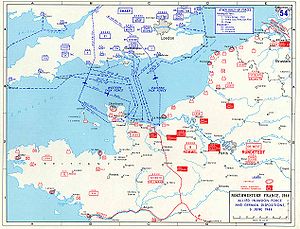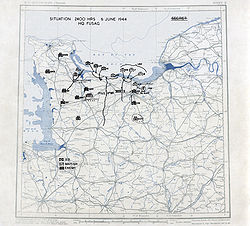- D-Day (military term)
-
For the first day of the Invasion of Normandy, see Normandy Landings.
 Battle plans for the Normandy Invasion, the most famous D-Day.
Battle plans for the Normandy Invasion, the most famous D-Day.
D-Day is a term often used in military parlance to denote the day on which a combat attack or operation is to be initiated. "D-Day" often represents a variable, designating the day upon which some significant event will occur or has occurred; see Military designation of days and hours for similar terms. The initial D in D-Day has had various meanings in the past, while more recently it has obtained the connotation of "Day" itself, thereby creating the phrase "Day-Day", or "Day of Days".[1] On the same principle, the equivalent terms in French, Basque, Romanian, Slovenian and Swedish are Jour J, E eguna, Ziua-Z, Dan D and Dagen D,[citation needed] and Tag X in Germany.
The best known D-Day is June 6, 1944 — the day of the Normandy landings — initiating the Western Allied effort to liberate mainland Europe from Nazi occupation during World War II. However, many other invasions and operations had a designated D-Day, both before and after that operation.[2]
The terms D-Day and H-Hour are used for the day and hour on which a combat attack or operation is to be initiated. They designate the day and hour of the operation when the day and hour have not yet been determined, or where secrecy is essential. For a given operation, the same D-Day and H-Hour apply for all units participating in it.
When used in combination with numbers, and plus or minus signs, these terms indicate the point of time preceding or following a specific action. Thus, H−3 means 3 hours before H-Hour, and D+3 means 3 days after D-Day. (By extension, H+75 minutes is used for H-Hour plus 1 hour and 15 minutes.)
Planning papers for large-scale operations are made up in detail long before specific dates are set. Thus, orders are issued for the various steps to be carried out on the D-Day or H-Hour minus or plus a certain number of days, hours, or minutes. At the appropriate time, a subsequent order is issued that states the actual day and times.
In spacecraft launchings, NASA utilizes the term 'T-Time' for the timing of the launch sequence down to the second (rather than M-Minute and S-Second), as in the expression "T minus 10 seconds and counting" for their countdown clock.
When referencing a local time zone, "Zulu" refers to Universal Co-ordinated Time (formerly Greenwich Mean Time). For other zones see list of military time zones.
History
The earliest use of these terms by the U.S. Army that the United States Army Center of Military History has been able to find was during World War I.[citation needed] In Field Order Number 9, First Army, American Expeditionary Forces, dated 7 September 1918: "The First Army will attack at H hour on D day with the object of forcing the evacuation of the St. Mihiel Salient."
D-Day for the invasion of Normandy by the Allies was originally set for June 5, 1944, but bad weather and heavy seas caused Gen. Dwight D Eisenhower to delay until June 6 and that date has been popularly referred to ever since by the short title "D-Day". Because of the connotation with the invasion of Normandy, planners of later military operations sometimes avoided the term to prevent confusion. For example, Douglas MacArthur's invasion of Leyte began on "A-Day", and the invasion of Okinawa began on "L-Day". The Allies' proposed invasions of Japan would have begun on "X-Day" (on Kyūshū, scheduled for November 1945) and "Y-Day" (on Honshū, scheduled for March 1946).
Notes
- ^ "D-Day". The Oxford Companion to World War II. Oxford: Oxford University Press. 2005. pp. 220. ISBN 0-19-280666-1.
- ^ Hakim, Joy (1995). A History of Us: War, Peace and all that Jazz. New York: Oxford University Press. ISBN 0-19-509514-6.
External links
Categories:- World War II Western European Theatre
Wikimedia Foundation. 2010.

